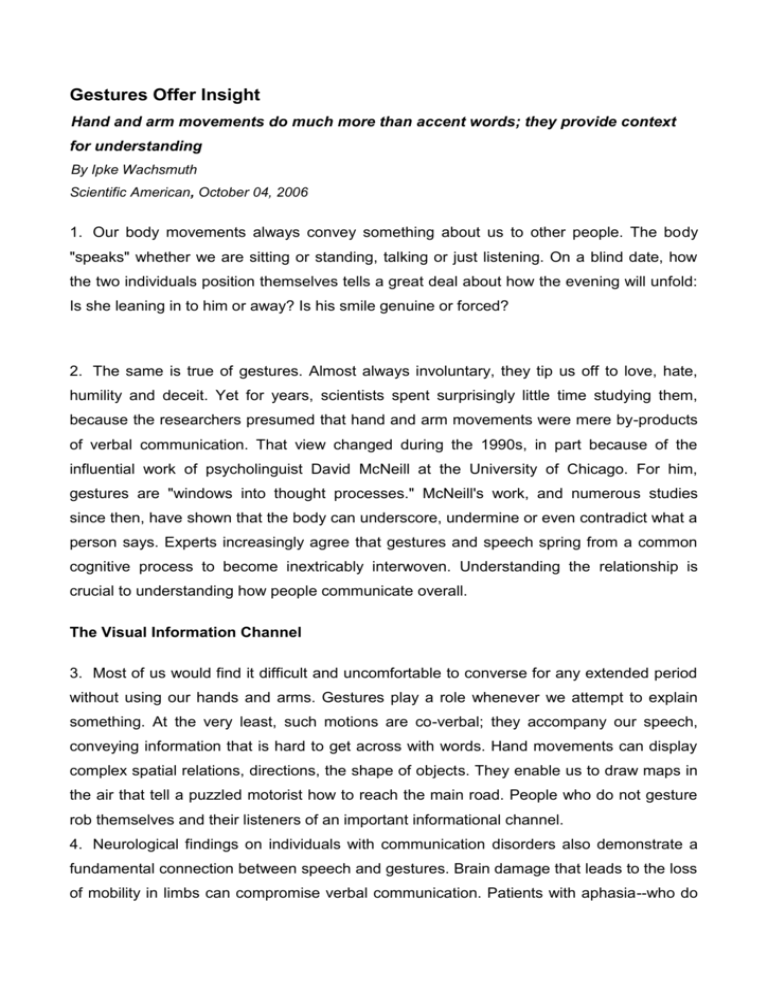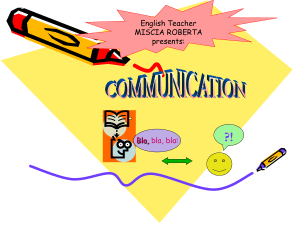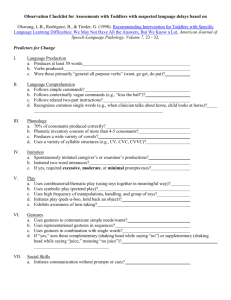Title Paragraph 9 insight determine
advertisement

Gestures Offer Insight Hand and arm movements do much more than accent words; they provide context for understanding By Ipke Wachsmuth Scientific American, October 04, 2006 1. Our body movements always convey something about us to other people. The body "speaks" whether we are sitting or standing, talking or just listening. On a blind date, how the two individuals position themselves tells a great deal about how the evening will unfold: Is she leaning in to him or away? Is his smile genuine or forced? 2. The same is true of gestures. Almost always involuntary, they tip us off to love, hate, humility and deceit. Yet for years, scientists spent surprisingly little time studying them, because the researchers presumed that hand and arm movements were mere by-products of verbal communication. That view changed during the 1990s, in part because of the influential work of psycholinguist David McNeill at the University of Chicago. For him, gestures are "windows into thought processes." McNeill's work, and numerous studies since then, have shown that the body can underscore, undermine or even contradict what a person says. Experts increasingly agree that gestures and speech spring from a common cognitive process to become inextricably interwoven. Understanding the relationship is crucial to understanding how people communicate overall. The Visual Information Channel 3. Most of us would find it difficult and uncomfortable to converse for any extended period without using our hands and arms. Gestures play a role whenever we attempt to explain something. At the very least, such motions are co-verbal; they accompany our speech, conveying information that is hard to get across with words. Hand movements can display complex spatial relations, directions, the shape of objects. They enable us to draw maps in the air that tell a puzzled motorist how to reach the main road. People who do not gesture rob themselves and their listeners of an important informational channel. 4. Neurological findings on individuals with communication disorders also demonstrate a fundamental connection between speech and gestures. Brain damage that leads to the loss of mobility in limbs can compromise verbal communication. Patients with aphasia--who do not have the ability to speak or to understand speech--also find it difficult to gesture or understand signs by others. These cases and others suggest that the very brain regions responsible for speech control gestures. Which Came First? 5. Observing young children can provide clues to the common development of oral and visual communication. Up to the age of nine to 12 months, babies reach out with all the fingers of their open hand for whatever object they want--similar to the chimpanzee begging for food. A neuronal maturational shift occurs at about 10 or 11 months in girls, somewhat later in boys: babies begin to point with one finger rather than all the fingers. The effort to get hold of an object is transformed into directed pointing, usually to get the attention of a caregiver. The pointing also usually accompanies a baby's initial attempts at verbal symbolization ("da," "wawa"), even though the early attempts frequently fail. A more nuanced gesturing vocabulary begins to develop as fine-motor finger control improves, between nine and 14 months, yet the spoken word continues to lag behind. 6. Synchronized word-gesture combinations begin to be seen in parallel with the child's developing word usage at 16 to 18 months, ultimately leading to children and adults who "embody" with their hands and arms the shape of an object, how people in a group exercise are positioned relative to one another in space, even abstract and metaphorical thoughts. Put your two palms together, lay them aside your right ear, close your eyes, and lean your head to the side--most people will understand that posture as a symbol for "sleep." Orators know that a well-placed gesture can be the best way to make a point hit home. 7. These conventionalized gestures can work without our having to say anything. But McNeill is particularly interested in the connection between spontaneous gestures and the spoken word. Adam Kendon, a cognitive scientist and founder of gesture research, hypothesized that both might stem from the same thought. He observed that the so-called gesture stroke of a co-verbal hand sign--the actual conveyor of meaning, such as mopping one's brow--is enacted shortly before or at the latest when its verbal affiliate is enunciated. 8. According to McNeill's theory, the process of speech production and the process of gesture production have a common mental source. This mental source includes a mixture of preverbal symbols and mental images and serves as a point of origin for the thought that is to be expressed. This growth point, as McNeill calls it, represents a kind of seed out of which words and gestures develop. Think First, Gesture Later 9. Different languages clearly differ in how information is conveyed, McNeill says. His former doctoral student, Gale Stam, now at National-Louis University in Chicago, uses this finding to determine whether a Spanish speaker who is learning English is beginning to think in English. If his gesture stroke continues to fall on the verb "climb" while speaking English, he is probably still thinking in Spanish and thus is purely translating. If the gesture stroke spontaneously falls on the preposition "up," she assumes that the transition to thinking in English has occurred. 10. The growing appreciation among scientists for the tight interweave between speech, thought and gesture is giving rise to theories about how the brain creates and coordinates these functions. One influential new model comes from psychologist Willem Levelt of the Max Planck Institute for Psycholinguistics in Nijmegen, the Netherlands. According to Levelt, the brain produces a verbal utterance in three stages. First the brain conceptualizes an intended message as purely preverbal information--as a concept that is not yet formulated linguistically. In the second stage, the brain finds words for this concept and constructs sentences--again, a purely internal process. Only in the third stage do the organs of articulation come into play, producing the desired utterance via the lungs and vocal cords. 11. One of Levelt's students, Jan-Peter de Ruiter, has incorporated gestures into this model. He assumes that the initial conceptualization stage also encompasses a visual precursor for gestures. According to de Ruiter, the brain creates gestural sketches. In the second stage, the sketch is transformed into a gestural plan--a set of movement instructions--that leads to muscle motor programs in the third stage. These programs tell our arms and hands how to move. 12. This model helps us to understand why gestures may precede the speech they are meant to accompany. The words first have to be assembled into a grammatically sensible expression, whereas the motion is conveyed by standard motor instructions. De Ruiter is examining in greater detail the presumed interaction between speech and gesture for pointing motions. He has recorded dialogues between two people telling each other stories and has found that an extended gesture--such as when someone points up toward the sky-tends to delay the verbalization to which it refers ("the plane ascended at a steep angle"). Gestures also adapt to speech; when a storyteller has misspoken and stumbles momentarily, a pre-prepared gesture appears to be held in abeyance until the speech component is running smoothly again. 13. These kinds of insights show that understanding how the body communicates is crucial to understanding verbal communication. Spoken words are not the only way humans convey meaning. As professional orators have known for centuries, a well-placed gesture can be the most effective way to make a point hit home. The more we learn about how the body communicates, the better we will become as communicators and observers. Questions 1. The example of individuals on a blind date is brought to show that ____________ ____________________________________________________________________ 2. In the first sentence of paragraph 2 the writer says, “The same is true of gestures.” What is true of gestures? ____________________________________________________________________ 3. What view changed in the 1990s? ___________________________________________________________________ 4. While in the past gestures were considered as_____________________________ ______________________, today experts understand that ____________________ ___________________________________________________________________ 5. According to paragraph 2, it's essential that we understand the relationship between _____________ and ____________________in order to understand ____________________________. 6. How can we describe gestures? Gestures are a. something we do consciously b. usually contradictory to what a person says c. an important part of communication d. a cognitive process 7. Paragraph 3: People can use hand movements to: i. ___________________________________________________________ ii. ___________________________________________________________ iii. ___________________________________________________________ iv. ___________________________________________________________ 8. The example of patients with aphasia shows that ___________________ _______________________________________________________________ 9. Observation of young children leads to a conclusion that a. children behave like chimpanzees b. babies progress when they move from opening the entire hand to pointing with one finger. c. children learn gesturing before actually speaking. d. once children learn to speak, they begin gesturing 10. There's no universal gesture to indicate sleep. (Circle one) TRUE / FALSE Support your answer with a quote from the text:___________________________ __________________________________________________________________ __________________________________________________________________ 11. McNeill WOULD/ WOULD NOT be particularly interested in the symbol for sleeping because it INVOLVES / DOESN'T INVOLVE speech. 12. According to Adam Kendon, speech (precedes/follows) a gesture. Copy from the text to justify your answer __________________________________________________________________ 13. According to paragraph 8, what precedes a thought formation? Complete the sentence: A thought stems from _________________________________________________. 14. Why does Gale Stam study gestures? To see whether a. b. c. d. Spanish speakers gesture as much as English speakers all languages use the same gestures learners of a new language begin thinking in that language English is harder to speak than Spanish. 15. (a) Levelt describes different stages of producing a verbal utterance: USE 1-2 WORDS FOR EACH a. __________________________ b. __________________________ c. __________________________ b). In what way did Jan-Peter de Ruiter add to Levelt's model? _________________________________________________________________________ 16. (circle the correct words) Gestures come before the words they are supposed to emphasize. This is because gestures/words are more automatic, while gestures/words require more preparation. 17. What is the main idea of the article ? a. Spoken words are always connected to gesturing b. Understanding how the body communicates is vital to understanding verbal communication. c. When a child points with one finger, we have to see that he is gesturing. d. Hand and arm movements accent words, and thus help to understand the verbal message Vocabulary exercises: Find the following words in the text and study their meanings in context: Title insight Paragraph 9 determine Paragraph 2 verbal common crucial Paragraph 10 rise produce Paragraph 3 extended attempt Paragraph 11 initial Paragraph 12 smoothly Paragraph 5 effort(s) Fill in the blanks with the words from the list above. You may need to change the form of the word: 1. New immigrants make great _________________ to learn the language and the customs of the host country. 2. The glass industry ________________ 10 tons of glass from recycled bottles every month. 3. Although the singing performance of the new star went _________________, the judges criticized it. 4. Observation of the tiny details is the most ___________________ characteristic of a detective. 5. While “The Little Prince” was ________________ written for children, it became popular among the adults as well. 6. Spiritual people often have ___________________, which help them make the right decisions in their lives. 7. The cat crawled quietly in an ____________________ to catch the bird. 8. The __________________ wish of people all over the world is to live in peace. Translate the following words or phrases as they are used in the text. You need to pay attention to the parts of speech. 1. accent (subtitle) _____________________ 2. position (para. 1) _____________________ 3. visual information channel (subtitle) _____________________ 4. complex spatial relations (para. 3) ______________________ 5. shift (para. 5) ___________________ 6. fine-motor finger control improves (para. 5) _________________________________ 7. Synchronized word-gesture combinations (para. 6) _________________________ _____________________ 8. relative (para. 6) ____________________ 9. common mental source (para. 8) ______________________ 10. grammatically sensible expression (para. 12) _______________________________ 11. standard motor instructions (para. 12) _____________________________________ Useful grammar Study the following examples: 1. Our body movements always convey something about us to other people. (para. 1) 2. The body "speaks" whether we are sitting or standing, talking or just listening. (para. 1) In the first sentence “s” signals the plural form of a noun, while in the second sentence “s” marks the singular form (he, she, it) of the verb in the present form. Some of the following sentences contain a grammar mistake. Correct the mistake by adding/taking off “s” where necessary: 1. Pet often feel the mood of their owners. 2. It has been proved that classical music alleviate stress and reduce anxiety. 3. GPS helps the driver get to his destination in the easiest and the quickest way. 4. Israel export citrus fruit such as lemons and oranges. 5. Depression rate are higher in northern countries since peoples in such countries are deprived of sunshine. 6. My grandparents consumes organic food, which is rich in fibers and low in fats and cholesterol.








